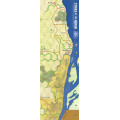Against the Odds 62 - Strike of the Heron
ATO62
Red price
- English
- From 14 years old
- 3 to 4h
- 2 player(s)
Strike of the Heron - The Approach to Stalingrad explores the sudden and astonishing breakthrough operation “Fischreiher” (Heron) by the German XIV Panzer Korps and other supporting units, to the Volga River in August, 1942.
It sent shock waves all the way up to Stalin and his Front commanders as the Soviets had been able to previously repel German attacks, allowing only a slow advance.
This rapid breakthrough and arrival of German units along the banks of Volga River at Rynok (just north of Stalingrad proper) on August 23rd also cutoff chances of a general offensive by Soviet forces on the German’s left flank to the north. This had been part of STAVKA's overall plan but had to be hastily abandoned.
The suddenness of their success even caught the Germans off guard. How to keep and further exploit their break- through? All the units in the Panzer Korps had suffered losses prior and all were somewhat understrength. Many of the AFVs were Panzer II, the rest mostly Panzer III, and maybe 30 long barreled Panzer IV. The corridor was not wide, just a few miles and many miles long....
The Soviets did react quickly and by Aug. 24th were launching counter thrusts against the base of the German corridor (near the Don), on both the German's right and left flanks. But, like the Germans, the Soviets were also weak. Their divisions were really at brigade strength, with around 4000 men. Their tank corps averaged 50 AFVs, but many times half of these were light tanks. The Soviet euphoric attacks managed to cut the corridor briefly, forcing the Germans to re-supply themselves by air, but had turned into a dire defensive action within a few days.
A second Soviet "pincher" offensive against the corridor nearer to Stalingrad was launched from Kotluban' to the north and Orlovka to the south in early Sept. Using the newly formed 24th and 66th Armies, plus the 4th, 7th and 16th Tank Corps’, along with elements of 1st Guards, slow gains were made but eventually faltered. The Soviets lost 200 tanks. The Germans felt secure enough to begin major operations to enter and capture Stalingrad.
Copyright © 2025 www.philibertnet.com Legals - Privacy Policy - Cookie Preferences - Sitemap






